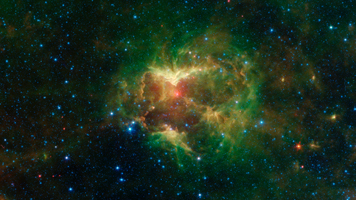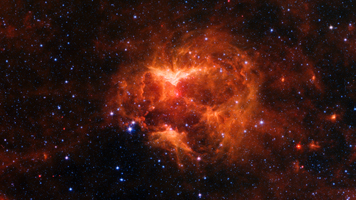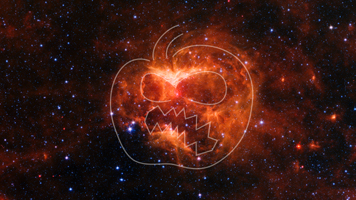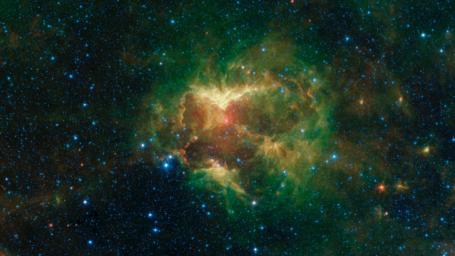
Figure 1

Figure 2

Figure 3
Click on images for larger versionsClick here for animation
This carved-out cloud of gas and dust has been nicknamed the "Jack-o'-lantern Nebula" because it looks like a cosmic hollowed-out pumpkin. Powerful outflows of radiation and particles from a massive star — known as an O-type star and about 15 to 20 times heavier than the Sun — has likely swept the surrounding dust and gas outward, creating deep gouges in the cloud. The image shows infrared light (which is invisible to the human eye) captured by NASA's Spitzer Space Telescope.
Figure 1 features three wavelengths of infrared light. Green and red represent wavelengths emitted primarily by dust radiating at different temperatures, though some stars radiate prominently in these wavelengths as well. The combination of green and red in the image creates yellow hues. Blue represents a wavelength emitted, in this image, mostly by stars and some very hot regions of the nebula. White regions are where the objects are bright in all three colors. The O-type star appears as a white spot at the center of a red dust shell near the middle of the scooped-out region.
Figure 2 is a high-contrast version of the same image in which the red wavelength is more pronounced. Together, the red and green wavelengths create an orange hue. The picture highlights contours in the dust as well as the densest regions of the nebula, which appear brightest.
Figure 3 shows figure 2 overlaid with a simple artist's drawing that reveals why researchers nicknamed this region the Jack-o'-lantern Nebula.
NASA's Jet Propulsion Laboratory, Pasadena, Calif., manages the Spitzer Space Telescope mission for NASA's Science Mission Directorate, Washington. Science operations are conducted at the Spitzer Science Center at the California Institute of Technology, also in Pasadena. Caltech manages JPL for NASA.
More information on Spitzer can be found at its website:
http://www.spitzer.caltech.edu/

 Planetary Data System
Planetary Data System















